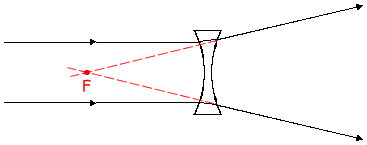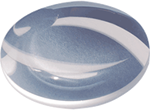GCSE level optics questions
Q7.
(a) The diagram shows how parallel rays of light pass through a convex lens.

(i) Mark the position of the focus.
See the diagram 
(1 mark)
(ii) Is this a converging lens, a diverging lens, both or neither?
It is a converging lens 
(1 mark)
(b) The diagram shows how parallel rays of light pass through a concave lens.

(i) Mark the position of the focus.
See the diagram 
(1 mark)
(ii) Is this a converging lens, a diverging lens, both or neither?
It is a diverging lens 
(1 mark)
(c) Complete these sentences by choosing the correct word or phrase from the brackets.
In a camera, a (converging  /diverging/parallel) lens is used to produce an image of an object on a (film
/diverging/parallel) lens is used to produce an image of an object on a (film  /lens/screen). The image is (larger than/smaller than
/lens/screen). The image is (larger than/smaller than  /the same size as) the object. The image is (nearer to
/the same size as) the object. The image is (nearer to  /further from/the same distance from) the lens, compared to the distance of the object from the lens.
/further from/the same distance from) the lens, compared to the distance of the object from the lens.
(4 marks)
(d) In a cinema projector, a convex lens is used to produce a magnified, real image.

(i) What does magnified mean?
Magnified means that the image is larger than the object. 
(1 mark)
(ii) What is a real image?
A real image is formed when rays from a point on an object converge at a point to form an image.  Such an image can be formed on a screen if it is placed at that position.
Such an image can be formed on a screen if it is placed at that position.
(1 mark)
(e) You are in a dark room. You have a box containing some lenses. Only one of them is a converging lens. Describe how, by just feeling the lenses, you can pick out the converging lens.
 A converging lens is convex shaped, that means it is thicker in the middle than at the edges. Therefore by feeling the shapes you would look for the one that bulged out in the middle.
A converging lens is convex shaped, that means it is thicker in the middle than at the edges. Therefore by feeling the shapes you would look for the one that bulged out in the middle.  The concave lenses in the box would be thicker around the edge than in the middle, any lenses that felt like that would therefore be rejected.
The concave lenses in the box would be thicker around the edge than in the middle, any lenses that felt like that would therefore be rejected. 
(2 marks)
(Total 12 marks)


